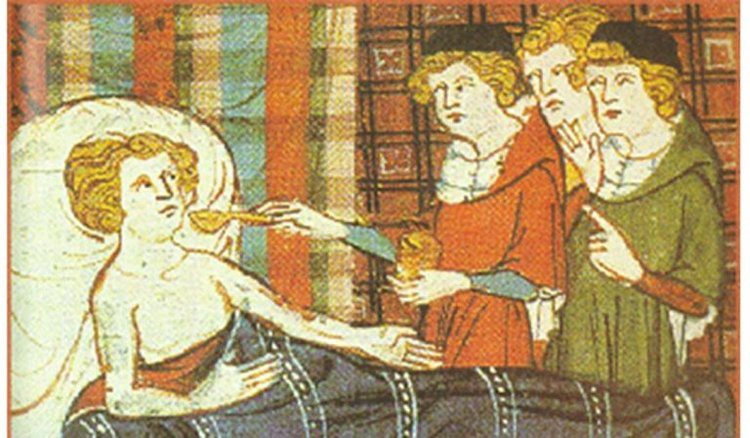












Born around 494 B.C., Empedocles was a Greek Pre-Socratic philosopher, whose contributions among many, include the theory of the four classical elements, earth, air, wind, fire (On Nature), which will be grouped as roots. He would argue that there are two forces which would either mix or separate them, Love and Strife. His works however, will implicate various dieties, whom authors would equate with each element/root.
Empedocles died around 434 B.C. His works have influenced thoughts on cosmogenesis, medicine, ontology, epistemology and much more.
Study Questions-O. James
© Orin James 2020

Born around 460 B.C. in Kos, Ancient Greece, Hippocrates is considered by many as The Father of Western Medicine. Since Hippocrates, it has become customary for new doctors to take and abide by the Hippocratic Oath. Much of the teachings attributed to Hippocrates can be read in the text Hippocratic Corpus. Within this text, one can read thoughts on diseases, plagues, treatments and his view on mental illness. Very central to his thoughts on medicine was his concept of the four humors and maintaining their balance.
Hippocrates died around 370 B.C. in Larissa, Ancient Greece.
Study Questions-O. James
© Orin James 2020

Plato was born ca. 427 B.C.E and died ca. 347 B.C.E. One can never exaggerate Plato's influence on Western philosophy. All discourses ranging from the humanities to the natural sciences, from politics to warfare arguably stem from the thoughts of Plato. With a focus on the dialectic to reach the truth, Plato uses the dialogues of his lionized instructor, Socrates (possibly not the historical Socrates) to articulate strong argumentative views.
In Timaeus Plato focuses on a wide range of topics, including, the nature of the world, its creation and its soul therein. Of interest to us will be what is discussed towards the end of the piece, in which we revisit the concept of the four elements, the four humors and views on anatomy and physiology along with the soul.
Study Questions-O. James
© Orin James 2020

In Phaedrus , Plato addresses several issues, to which the idea of genuine true wisdom is the focus. Some of these issues include love, poetry, the soul and the use of rhetoric. As the dialogue between Phaedrus and Socrates plays out, one finds that what is important, is getting to the spiritual truth and this is no easy task as the truth resides in authentic living wisdom that exists in philosophy.
Study Questions-O. James
© Orin James 2020


Sophocles was born in Colonus near Athens around 496 B.C. He is considered one of the great Greek tragic dramatists. During his lifetime, he wrote over 120 plays, surpassing his contemporaries Aeschylus and Euripides. In his play Ajax, Sophocles puts on display madness as inflicted by the Goddess Athena on a mortal. This play highlights the classical belief that madness is imposed by the Gods and can only be remedied by the divine.
Sophocles died in 406 B.C. in Athens at the age of ninety.
Publius Ovidius Naso, also known as Ovid was born in 43 BC at Sulmo in central Italy. Ovids' collection of mythological tales, Metamorphoses, often links the idea of transformation as a result of love or lust. The resulting transformation can often be characterized as tragic, as is the case in Echo & Narcissus. Through, once again, the intervention of a deity, we see uncontrollable madness inflicted upon a mortal. Tales like this one has undoubtedly had a lasting impact on our understanding of madness and contributed significantly to twentieth century thinking on psychology as evidenced by Sigmmund Freud's essay On Narcissism.
Ovid died 17 or 18 A.D. in exile
Study QuestionsAs you answer these questions, cite specific examples from the text to support your answer.
-O. James
© Orin James 2020

The Medieval times proved to be a time when Western medicine was not only influenced by Christianity, but also by Islam. As we explore the development of medicine during the Medieval times, I would like you to research the following names with their respective contributions to medicine:
Study Questions-O. James
© Orin James 2020

The Black Death Pandemic is recorded as the deadliest in human history. It is estimated that well over 100 million people might have died from the Black Death world wide, while diminishing Europe's population by 30%-60% during the 14th century. The onset of this pandemic would have a continual impact on health care practices for centuries to come.
Study Questions-O. James
© Orin James 2020
Bedlam, one of Europe's earliest mental hospitals was established as early as the 13th century in London. Like many of the mental institutions that came after, it illicits a horrific image of the type of care and treatment the clients would receive. In the early 19th century we witness the introduction of widespread institutionalized provisions to aid and study mental illnesses. The inhumane strategies employed by these institutions have since proven ineffective and fortunately removed. In this section, we explore the asylum and its various practices.
Study Questions-O. James
© Orin James 2020

The University Library System offers quite an array of sources to explore the history of care within the United States. Recently, the University Library Systems Archives and Special Collections has provided the public access to the Guide to the Western Pennsylvania Hospital and Dixmont Hospital Records, 1848-1918.
The abstract of this collection, states: "The Western Pennsylvania Hospital was founded in 1848 with a mission to care for the poor who were ill and the insane of the Pittsburgh area. The hospital created a Department of the Insane, which was later relocated to Kilbuck Township and became known as Dixmont Hospital, while the main medical facility remained in the city of Pittsburgh. The records found here consist primarily of annual reports of these two institutions that shared a common board of managers for many decades but later became independent from each other. Digital reproductions of the reports in this collection are available online."
The entire collection is divided into a four-part series, Series I. Annual Reports of the Managers of the Western Pennsylvania Hospital Series II. Annual Reports of the Managers of the Western Pennsylvania Hospital (includes a report for the Insane Department/Dixmont) Series III. Annual Reports of the Managers of the Dixmont Hospital for the Insane,1869, 1906, 1908, 1910-1912, 1915-1918 Series IV. Assorted Records
I would like for you to simply begin exploring these records to gain insight into what measures were initially taken to develop a new hospital, before delving deeper.
Study Questions-O. James
© Orin James 2020
Mid to late 20th century saw the beginnings of new approaches to understanding mental disorders. Ideas focusing on the importance of the individual and society began to emerge. One of the more dominant approaches was introduced by Sigmund Freud. Here the concept of the id, ego, superego would go on to describe why an individual may experience inbalance in mental health. Freud describes stages in which the pysche develops and defense mechanisms that may be in place to counter any attempts to change an individual's personality.
Study QuestionsHow many regions comprise the mind according to Freud? What are they?
What are the stages of personality development according to Freud?
What are some defense mechanisms in place?
-O. James
© Orin James 2020

Now that we have been introduced to early 20th century thoughts on mental health, specifically Freud's psychoanalysis, we can try to apply them. Read the following tales and see if you can identify instances where Freud's ideas on defense mechanisms can be applied: Rumpelstiltskin and The Girl without Hands
Study Questions-O. James
© Orin James 2020

As the 20th century progressed, so did new ideas on psychology. Theories that incorporated personal and environmental interactions came to the forefront. Key figures like Alfred Adler, Erik Erikson and several others came to dominate personal development theories, while behavioral theories were championed by the likes of Ivan Pavlov, Abraham Maslow among others.
Study Questions-O. James
© Orin James 2020
-O. James
© Orin James 2020